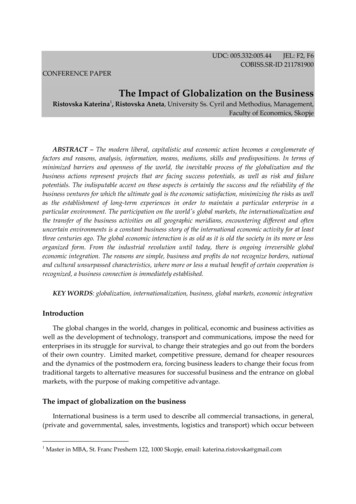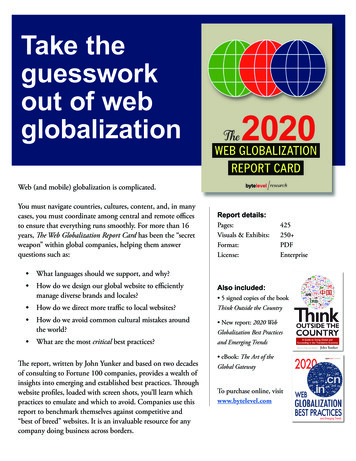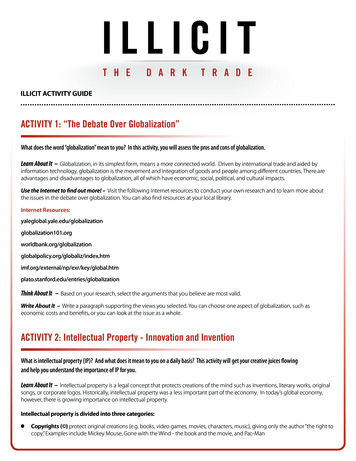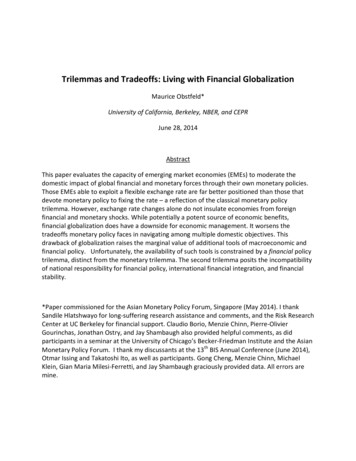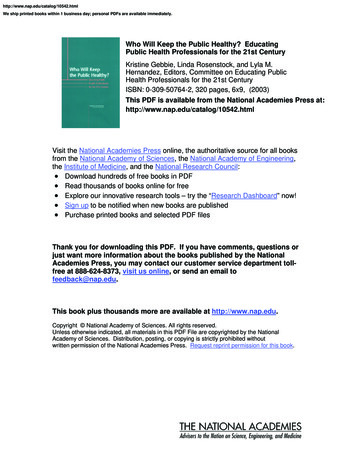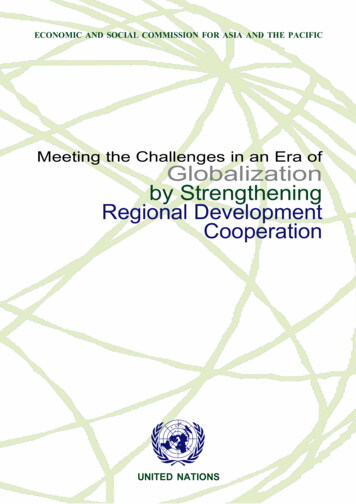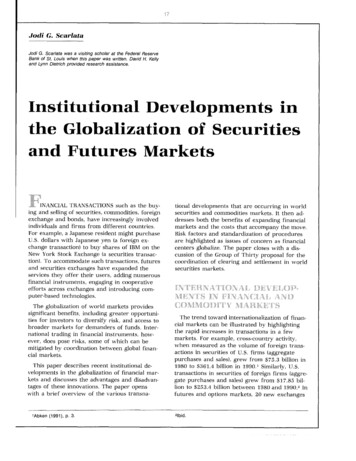
Transcription
Jodi G. SeariataJodi G. Scarlata was a visiting scholar at the Federal ReserveBank of St. Louis when this paper was written. David H. Kellyand Lynn Dietrich provided research assistance.Institutional Developments inthe Globalization of Securitiesand Futures Markets-anINANCIAL TRANSACTIONS such as the buying and selling of securities, commodities, foreignexchange and bonds, have increasingly involvedindividuals and firms from different countries.For example, a Japanese resident might purchaseU.S. dollars with Japanese yen (a foreign exchange transaction) to buy shares of IBM on theNew York Stock Exchange (a securities transaction). To accommodate such transactions, futuresand securities exchanges have expanded theservices they offer their users, adding numerousfinancial instruments, engaging in cooperativeefforts across exchanges and introducing computer-based technologies.The globalization of world markets providessignificant benefits, including greater opportunities for investors to diversify risk, and access tobroader markets for demanders of funds. International trading in financial instruments, however, does pose risks, some of which can bemitigated by coordination between global financial markets.This paper describes recent institutional developments in the globalization of financial markets and discusses the advantages and disadvantages of these innovations. The paper openswith a brief overview of the various transna-lAbken (1991), p. 3.tional developments that are occurring in worldsecurities and commodities markets. It then addresses both the benefits of expanding financialmarkets and the costs that accompany the move.Risk factors and standardization of proceduresare highlighted as issues of concern as financialcenters globalize. The paper closes with a discussion of the Group of Thirty proposal for thecoordination of clearing and settlement in worldsecurities markets.The trend toward internationalization of financial markets can be illustrated by highlightingthe rapid increases in transactions in a fewmarkets. For example, cross-country activity,when measured as the volume of foreign transactions in securities of U.S. firms (aggregatepurchases and sales), grew from 75.3 billion in1980 to 361.4 billion in 1990.’ Similarly, U.S.transactions in securities of foreign firms (aggregate purchases and sales) grew from 17.85 bilhon to 253.4 billion between 1980 and 1990.2 Infutures and options markets, 20 new exchanges2lbid
18were established worldwide between 1985 and1989, bringing the total to 72. Likewise, nearly40 million futures and options contracts weretraded worldwide in 1988, an increase of ap-proximately 186 percent since 1983. Eurodollarinterest rate futures saw an especially largechange, increasing almost 70 percent annuallybetween 1983 and 1988. .Iih.wfrations of Gkibaliz:ationThe globalization of financial and commoditymarkets involves numerous activities and institutional developments that facilitate access to foreign markets, whether by a trader or a security.One of these activities is the cross-listing ofsecurities in several countries. Cross-listing simply means, for example, that a firm in the UnitedStates lists its stocks on a London exchange. In1990, the International Stock Exchange (ISE) ofLondon had one of the highest percentages (23percent) of foreign company stock listings.8Another trend is cross-country hedging andportfolio diversification. A U.S. trader, for example, can diversify a portfolio composed of U.S.stocks by buying stocks of a U.K. firm in London through a London broker. Globalization canalso mean holding membership in another country’s exchanges. For example, after “The BigBang” of 1986 in London, many US. securitiesfirms and banks apphed to buy seats on Londonexchanges!A third trend in the internationalization offinancial markets is called “passing the book,”whereby control of trading is passed betweentraders at exchanges around the globe. Thisenables 24-hour trading of a financial instrument.An example of this would be a U.S. investmentfirm trading from New York during U.S. andJapanese hours and from its London desk duringU.K. hours. The more common practice of pass3Baer, Evanoff and Pavel (1991), p. 11.4lbid.5Eurodollar deposits are dollar-denominated deposits outside the United States. Eurodollar interest rate futures contracts are futures contracts on the interest rates on thesedeposits. The figures are from Baer, Evanoff and Pavel(1991), p. 11.6For the New York Stock Exchange, the figure was 3.7 percent. U.S. Congress, Office of Technology Assessment(1990), p. 29.7The Big Bang was a deregulation effort for British financialmarkets which began on October 27, 1956. Examples ofchanges to the London equity markets are the end of fixedcommission rates; barriers between order-taking brokersand risk-taking market makers were broken down; and, theself-regulating Securities and Investment Board (SIB) wasing the position book between time zones is actually to transfer the handling instructions between traders. An example is a New Yorkcurrency trader who instructs the trader at hisSingapore office to track the price of a currencyduring evening hours in New York. When themarket reaches a particular price, the Singaporetrader will buy or sell, depending on instructionsfrom New York.One trend that does not involve actual tradingis the underwriting of corporate securitiesthrough offices outside the home country. Anunderwriter is a firm that buys an issue ofsecurities from a company, then resells it to investors. For the company issuing the securities,underwriting provides a guarantee that a certainamount of money will be derived from the saleof the securities that can be used for capital expenditure. A large stock issue may have undern’riters from several countries, for example, tocompensate for a country whose capital marketdoes not have the depth to handle large securities offerings.8 The distribution of underwritersacross several countries provides the issuingfirm with a wider access to funding. Investors,on the other hand, obtain a broader selection ofsecurities.EJan/’siopnIenta in intonaa ted Tradin.g Svsi.eansMore recently, the development of automatedtrading has received substantial attention. Automated or electronic trading systems allow agentsto make trades via computer, without the “openoutcry” or pit auction system.’ Interestingly,the development of much of the current automation is an extension of technological innovations originally developed for domestic markets.It is clear, however, that this automation has afestablished. The SIB is a non-governmental version of theSecurities and Exchange Commission (SEC) in the UnitedStates. Khoury (1990), p. 129.8Depth means that there are enough buyers and sellers ina market that a large transaction will not affect the price.9An example is the privatization of French companies in1986, where the value of these newly privatized companieswas approximately 30 billion, but the total value of listings on the Paris Bourse was only about 50 billion. U.S.Congress, Office of Technology Assessment (1990), p. 34.‘ Openoutcry occurs on an organized exchange when orders between buyers and sellers are traded between thirdparties in anonymity. The buyer/seller enters into a contract with the exchange or its representativeclearinghouse.
fected the globalization of financial markets considerably.The National Association of Securities DealersAutomated Quotations (Nasdaq) was one of theearliest developments in financial market computerization, beginning in 1971. Nasdaq provides computer listings of price information forseveral thousand companies. By 1982, the National Association of Securities Dealers (NASD)had produced the National Market System, whichprovided investors with information as saleswere completed, and by 1991, had developedthe Private Offerings, Resales, and Tradingthrough Automated Linkages (PORTAL) system.”From a computer terminal, PORTAL enablesusers to trade in unregistered domestic and foreign debt and equity securities.”Nasdaq has established computer telephonelinkage as well as automated trade executionand international clearing and settlement withthe International Stock Exchange of London andthe Stock Exchange of Singapore. Nasdaq hassince become a significant market for the listingof foreign securities, trading approximately 6billion in foreign securities as of 1991, up fromthe 2.6 billion in 1985.’ Thus, Nasdaq providesthe cross-listing of securities, together with therapid trade execution of an automated system.The growth of international trading has alsoaffected futures and options exchanges in theUnited States. The fact that traders could accessinstruments and overseas markets after normalU.S. trading hours had ended, provided a motivation for many of the extended-hour and 24-hourtrading initiatives (see shaded insert for examplesof extended trading hours and table 1 for automated trading systems).A significant portion of U.S. financial instruments, futures and options is traded at exchangesthroughout the world. That is, foreigners do nothave to use the Chicago Mercantile Exchange totrade Eurodollar contracts, a CME staple. For“PORTAL uses a book entry settlement system with nophysical delivery, eliminating the problem of unmatchedtrades. PORTAL is currently the only fully automated clearing and settlement system in the United States. Clearingand settlement issues, book entry and matching trades willbe discussed in more detail later in the text.2‘ Unregistered securities are not registered with the Securities and Exchange Commission (SEC). They are issued ina limited volume or by small companies.3‘ 5ee Nasdaq (1991), p. 16, for the 1991 figure, and NASD(1991), p. 15. for the 1985 figure.l4Hansell (1959), p. 187.example, in 1989, a third of the trade in contracts offered by the CME originated outside ofNorth America.’ In 1989, 10 percent of theCME’s daily volume was transacted overnight inan overseas exchange while the CME wasclosed.” Furthermore, in 1985, the CME andChicago Board of Trade together accounted for83 percent of all futures volume. By 1990, thefigure had fallen to 55 percent.’6 The attempt toregain market share instigated such CME expansions as extended trading hours and automatedtrading systems.Perhaps the most ambitious project in automated trading is Globex, an attempt to create a24-hour trading market originally proposed in1987 by the CME.’7 Globex is an electronic tradeexecution system whereby traders enter buyand sell orders that are matched automaticallyaccording to price and time priority.’ Originating as a strictly off-hours trading system, thepurpose of Globex is to enable continued activetrading beyond the CME’s regular tradinghours. The CME intends to use Globex to accessmarkets after its own close of business and regain some of the market share lost to foreignexchanges.Po1.Itrv’I’I.A.L (i i.i.NS .A.IN.D.n.us.x.s(I).i INT EI.4 .hi.ATIIJte&LIZJ8TtThe significant changes accompanying the internationalization of financial trading systems allow for the realization of substantial gains; atthe same time, globalization also exacerbates therisks already present in financial trading. Themost significant of these gains and risks aredescribed below.b nejit sni t.notaaiaza.n.onOne of the most important areas of progressis the speed with which information is processedand disseminated to market participants. Increased flow of market data provides greater“Ibid.6‘ CheslerMarsh (1991), p. 33.“The Chicago Board of Trade has since become a participant with the CME in the Globex project.“For detailed reading on automated trading systems, seeDomowitz (1990).
cc‘A.(DO).0‘UZ ’E E CtOt r 000.3Ct5 OCD— Ct’ Oq CtCt5 ’1E 0 Ct—, Ct.9oct CtCtOCt0 ACtO QCt CD C.t ‘0Ot’h ’15’SCt Ct?9-tOtO’”O CC — 0-ctft .r-. o0-o00’0Ct 0 ‘1‘-“OCtC.CtOCtCt—CtCttNCt ”0 , ,‘ 9 Ct9— ‘ ‘—-0 Zct—-0Ct—a gOCtCt0 00CD 1 —*Ctao ’5’ Ct’ ‘1 000—- s ’ CtTh.*’ r CtOCtOBs - oCt0 0,.Ct’oCttoCt’ -OCD0o.pCt‘- 0Ct O, o Do’10 -t“0-tCt9--CtCt-p,,Ct ta 0 Cth90 .0-9 Ct ‘7’CtThCDCt Cp99Ctr 0Ct0 0,Ct90- 0tCt ”‘0.Cts: A”0 oogj- j- ,9E— a’ CDt ‘ “CO,-’Ct o-, 0CD ,CD Ct OCtCtOCtCtCt --o.e0dUiUi fl aa -—5Ct? 0?Ct
gy increases the familiarity of foreign corporations and their operations. This spread of information reduces one of the traditional obstaclesto foreign investment and opens up both savingsand investment opportunities for firms and individuals. The payoff is a more efficient allocation of capital and, thus, a stimulus to productionand real output.Likewise, the advent of almost immediatetransfer of information around the globe reducesthe informational discrepancies between marketparticipants. Arbitrageurs, of course, attempt toprofit from price discrepancies. The more peoplehave access to the same information, however,the more likely price discrepancies will be spotted and acted upon. The divergence of pricesfrom their no-arbitrage relationship (which provides profit potentials), will be quickly arbitragedaway as both the quantity and speed of information transfer is enhanced! Another benefit of internationalization is access to markets otherwise inaccessible. As mentioned earlier, the Chicago Mercantile Exchangewill be accessible after regular trading hoursthrough Globex. Not only will U.S. traders nowbe able to operate after U.S. trading hours, butforeign traders can also use Globex to operateduring their own regular trading hours. Newmarkets enable investors to introduce diversityinto their portfolios in both the type of instrument and the country from which it is issued.Just as computerized systems, such as Globex,facilitate diversification and accessibility, so toocan other methods, such as cross-exchange listings and cross-memberships.Trading in financial assets, whether donedomestically or across national boundaries, involves risk. Some of these risks are more important in an international setting than a strictlydomestic setting. They occur primarily at various stages of the clearing and settlementprocess. Unlike risks commonly associated withprice uncertainty, the risks in clearing and settlement procedures involve uncertainty aboutthe timely payment of funds and the transfer ofassets in financial trades.t0An example of a no-arbitrage condition is that the difference between the cash and futures price of a storablecommodity, at any point in time, should reflect carryingcosts of storing the commodity until maturity. If the pricedifferential exceeds carrying costs, then there exists an in-An example of a typical securities transactioncan provide a clear illustration. Once a securitiestrade is executed, the member firms involvedsubmit the trade information for confirmationto the clearing agent. The trade is then compared and matched by computer for accuracyand the information on the trade is sent to therelevant members on either the day of thetrade or the day after. If both parties concurwith the conditions of the trade, the trade isready for settlement. At present, settlement insecurities occurs five days after the trade in theUnited States.Using this example, the next section will brieflydiscuss the concepts and institutions in clearingand settlement procedures before introducingthe specific risks of globalization. ,J ‘ ,C )C , .C“Clearing” a trade involves the confirmation ofthe type and quantity of the financial instrument being traded, the transaction date andprice, and the identification of the buyer andseller. “Settlement” means the fulfillment of theobligations of the transaction. In equities andbonds, for example, settlement means paymentto the seller and delivery of the security certificate or transfer of ownership to the buyer.The clearing and settlement process dependson the institutions that facilitate transactions.Commodities and securities exchanges providethe facilities for traders to conduct their business, establish and enforce trading rules, collectand distribute market and economic informationabout prices, and provide an institutional framework for arbitrating and settling disputes.Another institution—the clearinghouse—compares trades between parties and can remove risk from the settlement process.2’ Aclearinghouse places itself between the buyerand seller, ensuring that the buyer receives theinstrument purchased and the seller receivespayment. That is, by becoming the counterpartyto all trades, the clearinghouse guarantees everytrade. Each participant has a net obligation withthe clearinghouse to buy or sell the securitycentive to enter the market, that is, to buy today and sellat the higher futures price.21Trade comparison involves confirming and matching theterms of the trade to ensure accuracy.
Table 1Automated Trading SystemstSystem R9nsorPurposeInstrumentsAccessNew York MercantiteExchange (NYMEX)Computerized screen traoingsystem to automatically matchtrade on a first-in-first-outbasis. Allows traders loselect a standtng bid or offer(but are blind to thecounterparty chosen).Energy futures and futuresoptions for crude oil. heat-ngoil, gasoline, propane aridnatural gasAutomated Pu TradingCAPT)London InternationalFinancial FuturesExcnange (LIFFE)Intenoed to extend tradunghours to cover Europeantrading day Its aim is tocopy the life o’ the tradingfloor on to a computer screenFT-SE 100 index futures andmost of LIFFE’s maincontractsEJV (Electronic JointVenture)Gollaooration betweenF:rst Boston. GoldmanSachs. Morgan Stanley.Salomon Brotners.Shearson Lehman andCitbankTrading system that allowsdealers to buy and sellsecurIties electronicallyusing voice-activated computertecnnology. Also providesprice and analytic servicesCurrently restricted toTreasury bills and notes withmaturity of less than threeyears Once established, itexpects to extend cove’ageto all maturit.esEuroquoteEuropean Community (E national stock exonangesA European-wsde share tradingsystem Wit combine prco information from 12 EC exchangesinto an electronic feed f r sub0scribers Eventually. may oecome a full trading system andintegrate Euroquote wth a settlement system to decrease thecost and difficulties of settlingcross-country transactions. (Thisproposal has since been abandoned by the chairmen of Europes national stockEC stocksexchanges)GlobexChicago MercantileExchange (CME). Reutersand Chicago Board ofTrade CBOT)An automated t’ading systemw:tt, anonymous buy and sellorders that are matched Dyprice and t-me (See textfor detailsiTraded instruments will be:ntroduced in three separatewaves 1) financial futuresand options e.g - Eurodoltarfutures, futures and optionson Eurodollar currenciesDeutschemark. yen poundsterling. Canadian and A’ust’alan dollars Swiss francLIBOR. and US Treasurybond aid note futures aidoptions. 2) equity-relatedprooucts: ano 3) aq’iculturerelated futures.
23Table 1 (continued)Automated Trading SystemstSystem.J! L.Purpose— jnst p ftts—Quotron System IncCurrent testing of theprototype nvolves TneBank ot America. BarclaysBarnc. Chase ManhattanBank. Cnemical Bank.Citibank. red’t Suisse.Lloyds Banic. Midland Bank.Morgan Guaranty NationalWestminster. Swiss Bankcorp. and Union Bank ofSwrtzertand.Joint protect to develop acomputer system tiatautomatically matches anoexecutes ioreign exchar-getraoes.Trades n foreign excnangeSwss Options andE nancialFuturesExchange SOFFEX Owned by Switzerlandsthree leading stockexcnanges and tvelargest banksFully automated trading andclearung system. wherequotes and orcers arerecorded sorted andmatcned automaticallyThe computer screen is composed of five segments. eachw.th oifterent types ot unformaton and automatically updateothroughout the oay.Futures and options on the 13undertytng stocks and theSwiss Market Index tSMll abasket of Swtzerlands 24leading stockstOf these systems. only LiFFE’s APT system ano SOFFEX are currently .n operationNOTE For a more extensive survey ot automated systems. see Peter A. Abken Glooatizat.on of Stock Futures. andOptions Markets. Federal Reserve Bank of Atlanta Economic Review July/August1 91lbased on her net position with other participantsin the clearinghouse.A third institution—the depository—is an organization (not necessarily part of an exchange)that holds stocks and bonds for safekeeping onbehalf of their owners. It has a computerizedaccounting system to record and transfer ownership of securities between participants by integrating a book-entry system with a moneytransfer system.22The procedures for clearing and settlementvary across countries. At present, there arethree common methods of clearing and settlement. Each involves various combinations of thethree central institutions involved in futures andsecurities markets.book-entry system means a credit or debit to a customer’s account will transfer securities between buyer andseller. A money transfer system transfers the funds between the parties to the trade, such as a wire transfer22AThe first model is exemplified by the UnitedKingdom’s equities market. In this model, thereis neither a central depository nor a separateclearinghouse. Instead, the stock exchange itselfis responsible for trade matching and confirmation as well as providing a location for the delivery and receipt of securities and payments between traders. The second model, exemplified by Germany’sDeutscher Kassenverein depository system, hasno independent clearinghouse, but does have acentralized depository and a stock exchange thatprovides the matching and confirmation oftransactions. Once matched and confirmed, thetrade information is sent to the depository forsettlement. 23U.S. Congress, Office of Technology Assessment (1990),p. 5B.24lbidCA CCC CA AVC CC,QC’,AflViAAC
The third model, as seen in the U.S. equitiesmarket, contains all three institutions: a stockmarket, a central depository and an independent clearinghouse. For example, the NationalSecurities Clearing Corporation (NSCC), whichprocesses 95 percent of all equities trades in theUnited States, is jointly owned by the New YorkStock Exchange, the American Stock Exchange,and NASD.25 The majority of the securities forNSCC members, in turn, are held by the Depository Trust Company. The stock market and clearinghouse together match and confirm transactions. The clearinghouse also places itself between counterparties to trades, then passestrade information to the depository.28 I Iisk,s’ in (.Je.a ring a in.! SettiernentCredit (or counterparty) risk occurs when oneside of the transaction does not settle in full,either when due or on a later date. The existence of counterparty risk, which is of minimalsignificance in many U.S. markets because of aclearinghouse, can be critical in an internationaltransaction. The clearinghouse, generally wellcapitalized, guarantees that all trades will be honnored. In many international transactions, however, no clearinghouse exists. Thus, a traderlacks information about the counterparty’s reliability. Varying regulations on foreign tradingmay make it even more difficult to ascertain thesafeguards available to a trader in that market.Closely related to credit risk is liquidity risk,which is the risk that trades will not be settledat the appointed time, but at some undeterminedtime thereafter.27 At settlement, counterpartiesare exposed to both credit and liquidity risks.Liquidity risk occurs because settlement maynot occur on the specified date; credit risk occursbecause the other party may not deliver at all.Thus, at settlement, the parties may not knowwhether the problem will be one of liquidity orcredit. The settlement of international trades25U.S. Congress, Office of Technology Assessment (1990),p. 81.tmmFor related readings on clearance and settlement systems,see the monographs prepared by the Payment SystemStudies Staff of the Federal Reserve Bank of New York inthe references to this paper.27A temporary inability to convert assets into cash is oftenassociated with liquidity risk while bankruptcy of a counterparty is associated with credit risk. For a more detaileddescription, see Federal Reserve Bank of New York(February 1989).2mFor further reading on market risks, see Baer and Evanoff(1990).can exacerbate the problem of simultaneouslyexchanging securities for payment because oftime zone differences.28Another risk, replacement cost risk, occurswhen the price of the security changes betweentrade and settlement. When one party has defaulted and the price of the instrument changes,then one of the parties involved would be adversely affected by the price change and suffer’a loss in replacing the transaction. In foreignmarkets, the potential for adverse changes inthe exchange rate can exacerbate this risk.Operational risk occurs because of the possiblefailure of computer systems, telecommunicationsor institutionalized procedures during trading.Given the heavy reliance on technology in accessing financial markets abroad, this issue is extremely important in determining the success orfailure of new trading systems. The precautionstaken by the CME for its Globex system—an important part of its initial proposal to the Commodity Futures Trading Commission, a government regulator of futures exchanges—are a goodexample of this.29Yet another risk, especially worrisome to regulators, is systemic risk. Systemic risk occurswhen credit risks stemming from operational orfinancial problems result in agents exiting themarket, which, in turn, threatens the industry.The inability of one financial institution to makeits payments can cause other participants to beunable to meet their financial obligations in atimely manner. In the banking sector, this istypified as a run from deposits to currency. Infutures and options, it occurs when agents nolonger trade through standard channels like anexchange. For example, if members of an exchange begin trading elsewhere, the financialstability of the exchange is threatened as members withdraw their financial collateral.’ 29Examples of CME precautions include measures to prevent unauthorized individuals from accessing the system,such as four different identification codes; termination of acomputer operator’s session if nonstandard instructionsare entered; and, in the failure of the central computer,recovery would involve automatic switchover to a back-upmainframe, taking approximately 60-90 seconds. SeeCFTC (1989), pp. 125-32.3mFor further reading on systemic risks, see OECD (1991).
i i1C:C.,C Cit)t IiftCliI S: iiC:c. it itSThe October 1987 stock market crash, withworldwide repercussions, revealed weaknessesin the clearing and settlement system. Manyfeared that the default of a major market playercould threaten the financial systems of manycountries. This prompted world financial leaders to work toward global coordination. Theclearing and settlement of trades was considered one of the most crucial aspects of thiscoordination.In 1989, the Group of Thirty issued a report,Clearing and Settlement Systems in the World’sSecurities Markets.31 Based on its examination,five critical deficiencies in the clearing and settlement systems across countries were identified:[1] Absence of compatible trade confirmationand matching systems for both domestic andinternational trades;[2] Varying settlement periods across the different markets;[31 Absence of delivery versus payment in somemarkets;[4] Absence of standardized trade guarantees;[5] Absence of book entry processing for settlement of securities transactions in severalmarkets. t.:nnjnwnannr nnd .litriliij.gTrade confirmation and matching, also knownas trade comparison, is the process of confirming and matching the terms of a trade to ensureaccuracy (for example, the issue, price, quantityand counterparties) and is usually done by aclearinghouse (although sometimes by an exchange or by the parties themselves, in the forward foreign exchange market). If not confirmedand matched, a chain reaction of failed trades ispossible as subsequent trades are made on theassumption that earlier trades will be successfully completed.Rapid trade comparison shortens the amountof time between when the trade is made andwhen it is successfully matched. This reducescredit risk by reducing the amount of time an31The Group of Thirty is a private sector organization thattakes its membership from financial sectors such as exchanges, banks and investment houses.32Setttement risk encompasses both liquidity risk and creditagent has to opt for defaulting on a trade. Inthe international context, delays of hours in adomestic market may result in a delay of daysfor international trades. Requiring all investorsto obtain membership in a trade comparisonsystem and achieving a compatible system acrossinternational markets can reduce the delays andcredit risks involved in diverse systems.The second deficiency is unequal settlementperiods, which can increase settlement risk andpotential default. Settlement t1sk occurs whenthere are gaps in the timing of payments andreceipts on settlement date.32 The harm of different settlement periods is that, as mentionedearlier, traders or investors who are active participants in the market make later trades contingent on the assumption of the successful settlement of earlier trades. Hence, the harm is twofold—the default of an earlier counterparty andthe dependence on this trade that couldjeopardize subsequent trades. As with manytrade issues that require timeliness, delays insettlement can be exacerbated if spread acrossdifferent trading hours and time zones.While this is costly in a domestic market, theinvestment of a U.S. agent dealing in international markets can be even more costly becauseit is also subject to the economic conditions offoreign countries and exchange rates. Adversechanges in the exchange rate can turn a minorloss into a significant one in the presence ofcurrency risk. i’hus, for agents moving betweeninternational markets, an uncertain settlementperiod combined with an uncertain exchangerate can increase financial losses.The gro
of foreign securities, trading approximately 6 billion in foreign securities as of 1991, up from the 2.6 billion in 1985.' Thus, Nasdaq provides the cross-listingof securities, together with the rapid trade execution of an automated system. The growth of international trading has also affected futures and options exchanges in the United States.


